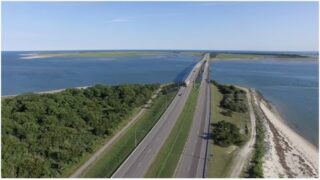OS OLHOS DO CÉU: COMO UM ANTIGO AVIÃO PODE TORNAR A COREIA DO NORTE MAIS PERIGOSA I Professor HOC
0Recently spoke to you about the possibility of North Korea developing a nuclear submarine, right? And today’s video is about another, less glamorous technology, but perhaps just as important to the country’s ambitions. In December 2023, researchers noticed something peculiar in satellite images of Sunan International Airport in Piyang, North Korea. An old Soviet cargo aircraft was being modified with structural struts on its wings. These struts could support a radar, thus transforming the plane into an airborne early warning system, capable of detecting enemy missiles and aircraft hundreds of kilometers away. This assessment was confirmed on March 27, when North Korean leader Kim Jong-un visited the aircraft’s interior, offering the public the first image of the completed system. These surveillance capabilities will help North Korea monitor military assets of its neighbor South Korea and the Americans constantly moving around the peninsula. In the event of an attack, the aircraft could detect cruise missiles long before they enter North Korean airspace. But perhaps more importantly, this aircraft could help North Korea finally overcome a technological problem that has haunted it for decades: the successful development of warheads for its intercontinental ballistic missiles capable of re-entering the atmosphere. Hey everyone, let’s pause the video so I can talk about our advanced militaries for two main reasons. First, they allow air forces to better see enemy aircraft. Although radar power is limited by aircraft size, its high-altitude positioning provides better visibility, overcoming limitations such as the Earth’s curvature, which is crucial for detecting low-flying aircraft like cruise missiles. This factor is particularly relevant for North Korea, whose mountainous terrain makes it difficult to detect cruise missiles. An airborne radar can look into valleys and provide valuable warning time before missiles reach their targets. And it could also detect ballistic missile launches from South Korea earlier than ground-based radars. The second reason is that airborne radars can be equipped with advanced communications technologies, allowing operators to share real-time data with other aircraft. North Korea uses tactical bombers to launch cruise missiles, and airborne radar could guide them more accurately. However, there are limitations. North Korea has few cargo planes suitable for this type of modification and has only produced one unit so far. Since it cannot remain airborne indefinitely, its use will be intermittent, likely during crises or military maneuvers by the United States or South Korea. But North Korea has never before operated an airborne early warning system. It’s unclear whether this is due to a lack of interest or a lack of technological capability. It’s possible that North Korea considered these systems useless in the face of US and South Korean air superiority. Something has now changed that assessment. It’s also possible that recent Russian technology transfers have resolved technical bottlenecks, something that hasn’t yet been proven, but it’s possible, as Russian weapons have been spotted on North Korean ships. Besides contributing to the survival of its dictator, King, by warning him of decapitation attacks, for example, an airborne radar could help North Korea perfect its ICBMs, long-range intercontinental ballistic missiles. Since the 1990s, the country has been trying to build ICBMs, initially adapting old Soviet designs. Today, it apparently already operates domestically manufactured CBMs with proven range. But North Korea has yet to demonstrate mastery of reentry technology. Nuclear warheads require durable heat shields to withstand atmospheric reentry. And North Korea has yet to demonstrate this capability. Over the past 10 years, the country has conducted 14 ICBM tests, but none has conclusively demonstrated the effectiveness of reentry vehicles. In November, Admiral Samuel Paparo, head of the United States Indo-Pacific Command, stated: “Quote: We haven’t seen that capability yet, just continued testing in that direction.” End quote. North Korea’s geography is an obstacle. ICBMs have a range of over 10,000 km, but the country is only about 1,000 km wide. In other words, testing missiles over the Pacific requires launching them over Japan, which could cause collateral damage and protests. Therefore, tests are conducted on short trajectories, which impose steeper reentry angles and much higher temperatures—an extreme environment for testing a nuclear warhead. And to make matters worse, North Korea likely can’t monitor reentry because of the Earth’s curvature. The country’s telemetry stations lose contact with the missiles at an altitude of about 140 km, before they even reenter the atmosphere. This limits the ability to understand why their warheads fail. None of this means that the threat from North Korean ICBMs is zero. Far from it, even with unstable or inaccurate warheads, they can still cause destruction. But the lack of evidence regarding effectiveness undermines the credibility of the country’s deterrent. If the King doesn’t convince Washington that it can hit targets in the United States, its deterrence with the Americans is much lower. Airborne radar can help solve these problems. Even with short-range tests, the aircraft can fly over the Sea of Japan and track re-entering warheads, collecting data on their accuracy and potential failures. To a lesser extent, the country’s geography also hinders cruise missile testing. North Korea has been testing these missiles with alternative trajectories off the east coast, which doesn’t reflect real combat scenarios. Conventional Hall missiles and nuclear Pawall missiles require complex navigation systems, such as downward-looking radar and cameras that compare the terrain with stored maps. This technology is difficult to master. In the 1991 Golf War, to give you an idea, the first version of the famous American Tomas Hawk missile had a success rate of only 50%. Decades later, the United States has perfected this system, but North Korea, with its limited and aging technology base, is still in the early stages. These navigation systems require extensive testing over land, and that’s where airborne radar comes in. It can track missiles much more accurately than ground-based platforms. Russia, for example, has a dedicated aircraft for this purpose: the I76 LL skip, the same model North Korea is converting. Both in the test field and in combat, airborne radar offers unique capabilities that ground-based radars cannot. Operationally, it can detect enemy missiles early. In testing, it can provide the data Kinjon needs to perfect its ICBM arsenal, significantly shortening development time. And of course, it’s not a magic solution. The system won’t explain why heat shields are failing. It will only offer some clues about how and when they fail. Material shortages or technical ignorance may continue to limit the program, but airborne radar can still provide the data North Korea desperately needs, making the country even more dangerous to its enemies and the world. I hope you enjoyed it. Hey guys. Don’t forget to like, follow the channel, activate the bell, share the video, and also come check out Rock Academy, my app, in the Apple and Google stores. See you later. M.









